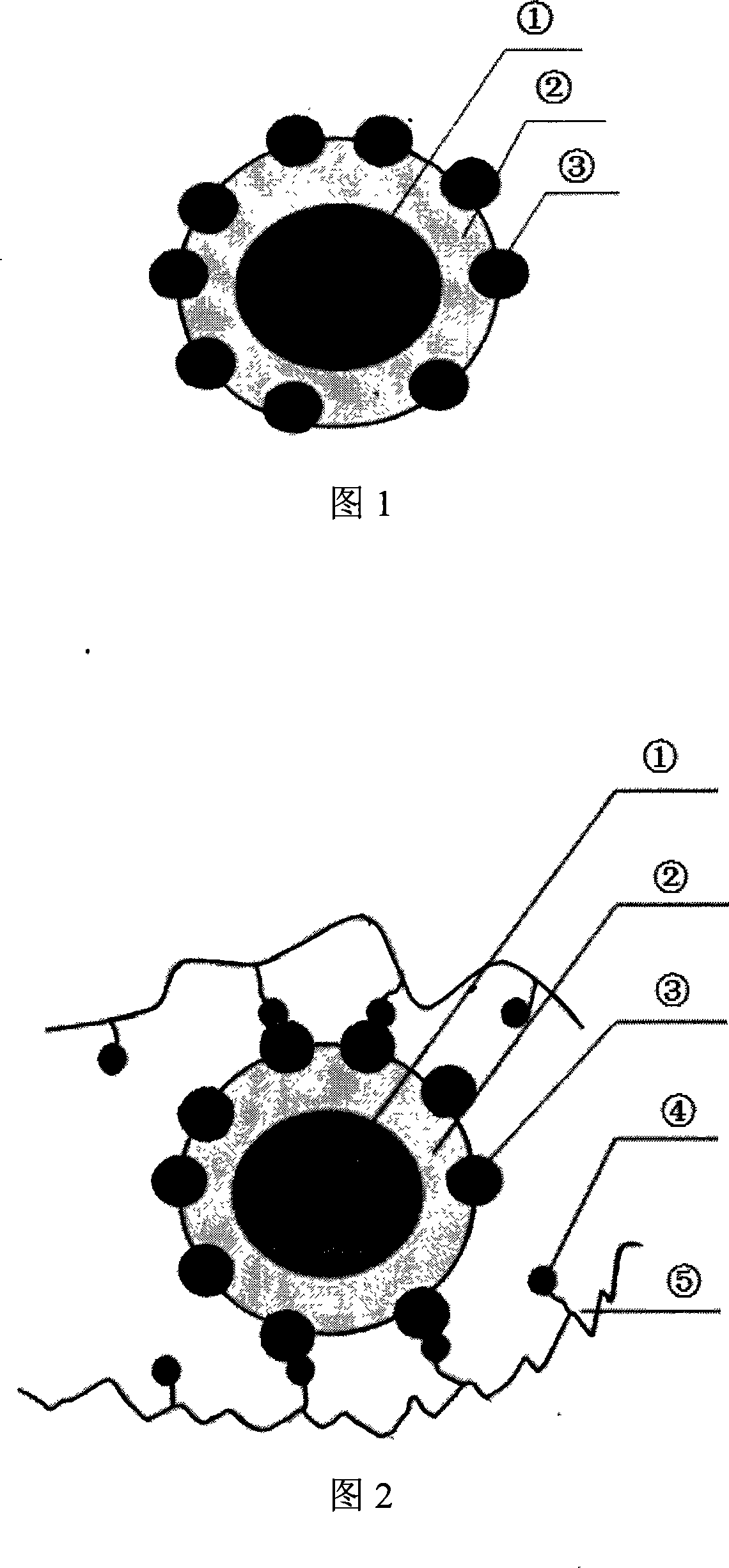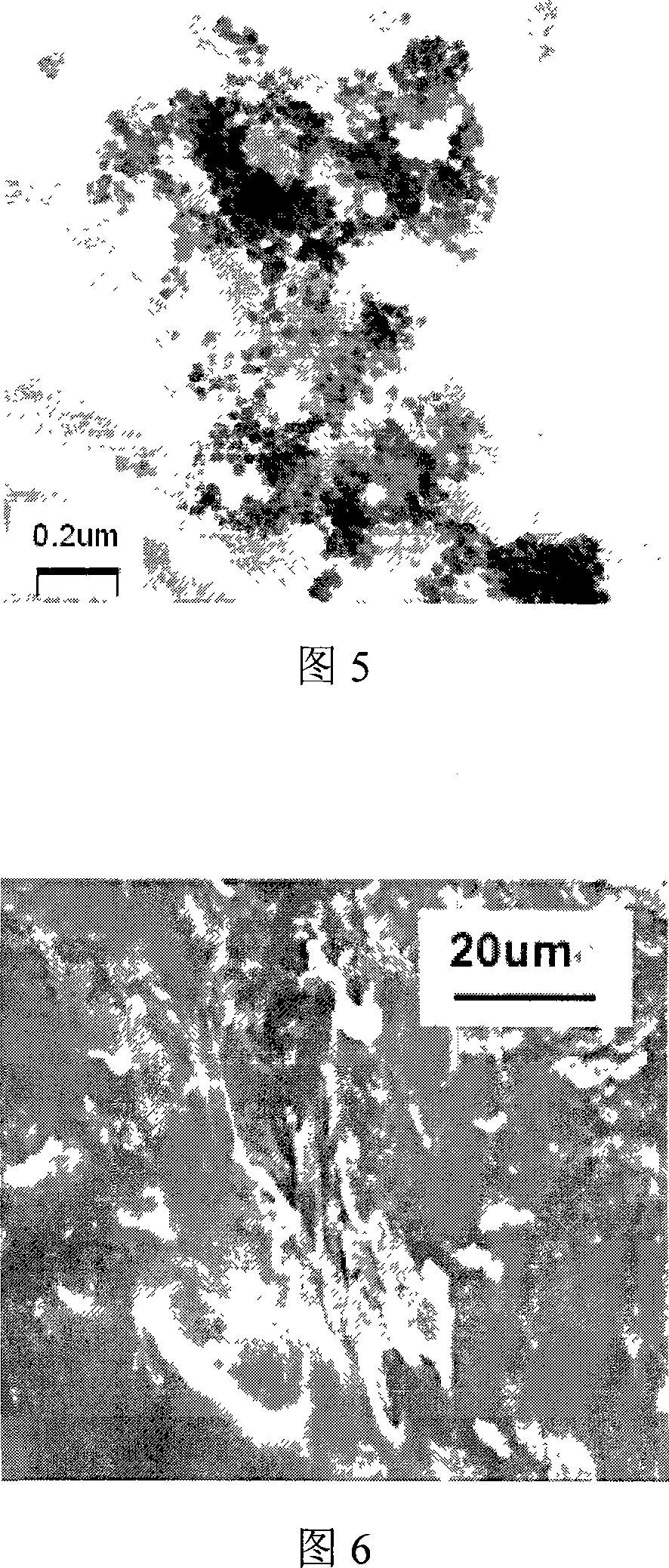Nucleocapsid type rubber coordination crosslinking agent
A coordination cross-linking, core-shell type technology, applied in the field of organic/inorganic core-shell type coordination cross-linking agents, can solve the problems of large copper sulfate, difficulty in obtaining strong rubber materials, and low coordination efficiency
- Summary
- Abstract
- Description
- Claims
- Application Information
AI Technical Summary
Problems solved by technology
Method used
Image
Examples
Embodiment 1
[0052] Materials used in this embodiment: nano-silicon oxide is selected for the inorganic particles, polymethacrylic acid (PMA) is selected for the shell polymer, and copper ions are used for the coordination metal ions introduced into the shell. The rubber matrix is powdered nitrile rubber (NBR).
[0053] Firstly, burn the surface of nano-silicon oxide at 600-650°C for 4-5 hours to remove a small amount of organic impurities on the surface. Weigh 10g of the above treated powder, and disperse it in 300ml of toluene by ultrasonic vibration; pour 0.5g of silane coupling agent KH570 into a small beaker, drop about 20 drops of deionized water, stir at room temperature for 10min to make it hydrolyzed in advance . Pour the above pre-hydrolyzed KH570 into toluene at one time. Raise the temperature to boiling, fast mechanical stirring, reflux condensation, nitrogen protection, and the reaction ends after 4 hours.
[0054] Put 300ml of the above suspension under nitrogen protecti...
Embodiment 2
[0058] Materials used in this embodiment: nanometer zinc oxide is selected for the inorganic particles, polymethacrylic acid (PMA) is selected for the shell layer polymer, and copper ions are used for the coordination metal ions introduced into the shell layer. The rubber matrix is ethylene-vinyl acetate copolymer (EVA).
[0059] Firstly, the surface of nano-zinc oxide is burnt at 600-650°C for 4-5 hours to remove a small amount of organic impurities on the surface. Weigh 10g of the above treated powder and disperse it in 400ml of toluene by ultrasonic vibration; pour 1.0g of silane coupling agent KH570 into a small beaker, drop about 25 drops of deionized water, stir at room temperature for 10min to make it hydrolyzed in advance . Pour the above pre-hydrolyzed KH570 into toluene at one time. Raise the temperature to boiling, fast mechanical stirring, reflux condensation, nitrogen protection, and the reaction ends after 6 hours.
[0060] Put 400ml of the above suspension ...
Embodiment 3
[0064] Materials used in this embodiment: the inorganic particles adopt ordinary light calcium carbonate (325 mesh, commercially available, produced by Zhejiang Jiande Tianshi Calcium Carbonate Co., Ltd.), the polymer shell adopts polymethacrylic acid, and the rubber matrix is nitrile rubber , the coordination center ion is copper ion.
[0065] First, ultrasonically disperse 10.0g of ordinary light calcium carbonate in 300ml of isopropanol, slowly add aminosilane coupling agent N-(aminoethyl)-aminopropyltrimethoxysilane dropwise under stirring condition and heat up to 60°C React for 3 hours, filter and dry and extract with acetone for 24 hours to obtain calcium carbonate powder treated with coupling agent. Add 10g of calcium carbonate powder treated with a coupling agent, 1g of azodicyanovaleric acid and 50g of thionyl chloride into a three-necked flask, drop in 1g of α-picoline, stir at 30°C for 2 hours, and centrifuge to obtain The precipitate was washed several times wit...
PUM
 Login to View More
Login to View More Abstract
Description
Claims
Application Information
 Login to View More
Login to View More - R&D
- Intellectual Property
- Life Sciences
- Materials
- Tech Scout
- Unparalleled Data Quality
- Higher Quality Content
- 60% Fewer Hallucinations
Browse by: Latest US Patents, China's latest patents, Technical Efficacy Thesaurus, Application Domain, Technology Topic, Popular Technical Reports.
© 2025 PatSnap. All rights reserved.Legal|Privacy policy|Modern Slavery Act Transparency Statement|Sitemap|About US| Contact US: help@patsnap.com



